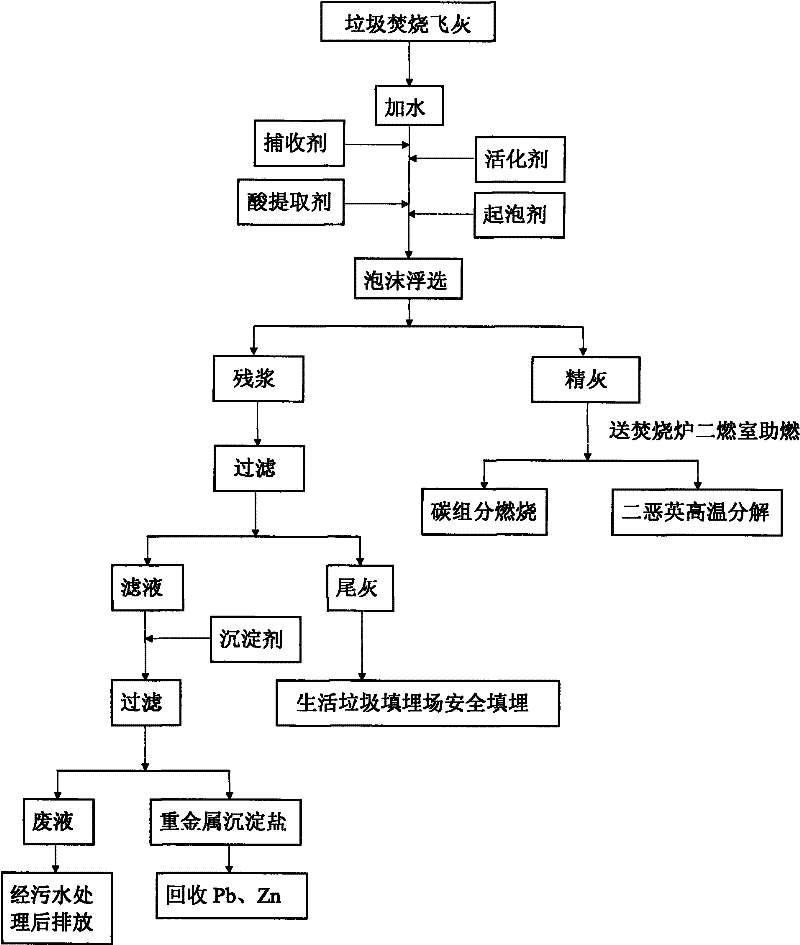Flyash treatment method for waste incineration
A technology for incinerating fly ash and medical waste, applied in the field of environmental pollution control, can solve the problems of high equipment cost, small incineration treatment capacity, easy high temperature volatilization of chlorides, etc., and achieves the effect of reducing volume and toxicity and reducing subsequent treatment costs.
- Summary
- Abstract
- Description
- Claims
- Application Information
AI Technical Summary
Problems solved by technology
Method used
Image
Examples
Embodiment 1
[0021] See Table 1 for the thermal loss rate, heavy metals, dioxins and chlorine contents of a certain medical waste incineration fly ash. Add 200g of medical waste incineration fly ash and 4 liters of deionized water into the slurry mixing tank at the same time, stir the mortar for 5 minutes to make the fly ash thoroughly wet, during this period, add 400ml of hydrochloric acid to the mortar as an acid extractant, and add 0.2g Diesel oil and 0.05 g of oleic acid were stirred for several minutes to blend the slurry. During this time, 0.05 g of terpineol oil was added to the mortar and stirred for several minutes to blend the slurry.
[0022] Table 1. Medical waste incineration fly ash heat loss rate, heavy metal, dioxin and chlorine content in Example 1
[0023]
[0024] The above-mentioned slurry is sent from the upper part of the flotation column 3 through the slurry inlet pump 2, and the air provided by the air compressor 7 enters from the lower part of the flotation colu...
Embodiment 2
[0035]The medical waste incineration fly ash sample that adopts is identical with embodiment 1, and the amount of hydrochloric acid added in the mortar is 800ml, and the medicament (collector, activator and foaming agent) that adds and other parameters are all the same as embodiment 1.
[0036] The above-mentioned flotation separation products (fine ash, tail ash, precipitated salt) were analyzed after dehydration and drying. The results are shown in Table 5. The dioxin content in the tail ash meets the dioxin limit required by GB16889-2008 (<3ng TEQ / g). At the same time, the dried tail ash was tested for heavy metal leaching concentration according to HJ / T300. The test results are shown in Table 6. The harmful concentration in the leach solution is lower than the concentration limit of heavy metal pollutants in GB16889-2008, indicating that the tail ash can be directly entered into domestic waste. Landfill landfill.
[0037] The thermal ignition loss rate, heavy metal, diox...
Embodiment 3
[0045] The medical waste incineration fly ash sample that adopts is identical with embodiment 1, and the hydrochloric acid amount that adds in mortar is 600ml, and the medicament (collector, activator and foaming agent) that adds and other parameters are all with embodiment 1.
[0046] According to the above conditions, the flotation separation products (fine ash, tail ash, precipitated salt) were analyzed after dehydration and drying. <3ng TEQ / g). At the same time, the dried tail ash was tested for heavy metal leaching concentration according to HJ / T300. The test results are shown in Table 9. The harmful concentration in the leach solution is lower than the concentration limit of heavy metal pollutants in GB16889-2008, indicating that the tail ash can be directly entered into domestic waste. Landfill landfill.
[0047] The thermal ignition loss rate, heavy metal, dioxin and chlorine content and heavy metal recovery rate of the flotation separation product in Table 8 Example ...
PUM
| Property | Measurement | Unit |
|---|---|---|
| concentration | aaaaa | aaaaa |
Abstract
Description
Claims
Application Information
 Login to View More
Login to View More - R&D
- Intellectual Property
- Life Sciences
- Materials
- Tech Scout
- Unparalleled Data Quality
- Higher Quality Content
- 60% Fewer Hallucinations
Browse by: Latest US Patents, China's latest patents, Technical Efficacy Thesaurus, Application Domain, Technology Topic, Popular Technical Reports.
© 2025 PatSnap. All rights reserved.Legal|Privacy policy|Modern Slavery Act Transparency Statement|Sitemap|About US| Contact US: help@patsnap.com



